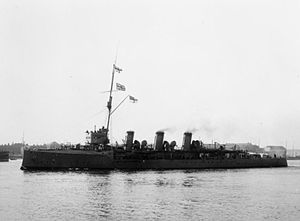Třída Sentinel
| Třída Sentinel | |
|---|---|
 HMS Skirmisher | |
| Obecné informace | |
| Uživatel | |
| Typ | lehký křižník |
| Lodě | 2 |
| Osud | vyřazeny |
| Předchůdce | třída Pathfinder |
| Nástupce | třída Boadicea |
| Technické údaje | |
| Výtlak | 2880 t[1] |
| Délka | 109,73 m (mezi svislicemi) 116,13 m (max.) |
| Šířka | 12,19 m |
| Ponor | 4,27 m |
| Pohon | 12 kotlů 2 parní stroje s trojnásobnou expanzí 17 000 ihp |
| Rychlost | 25 uzlů |
| Dosah | 3000 nám. mil |
| Posádka | 268 |
| Výzbroj | 10× 76mm kanón (10×1) 8× 47mm kanón (8×1) 2× 457mm torpédomet |
| Pancíř | 16–38mm paluba 76mm velitelská věž |
| Technické údaje 1912 | |
| Výzbroj | 9× 102mm kanón (9×1) 2× 457mm torpédomet |
Třída Sentinel byla třída lehkých křižníků Royal Navy. Celkem byly postaveny dvě jednotky této třídy. Ve službě byly v letech 1905–1921. Účastnily se první světové války. Jednalo se o menší lodi označované jako Scouts. Měly sloužit jako vůdčí lodi torpédoborců, jejichž novým typům však již nestačily rychlostí.
Stavba
Britská admiralita objednala stavbu osmi malých průzkumných křižníků, které měly v boji podporovat britské torpédoborce. Zakázka byla rozdělena mezi čtyři loděnice, takže vznikly čtyři třídy křižníků po dvou jednotkách. Jednalo se o třídy Adventure, Forward, Pathfinder a Sentinel. Dvě jednotky třídy Sentinel postavila v letech 1903–1905 loděnice Vickers v Barrow.[1]
Jednotky třídy Sentinel:[1]
| Jméno | Loděnice | Založení kýlu | Spuštěna | Vstup do služby | Poznámka |
|---|---|---|---|---|---|
| Sentinel (ex Inchkeith) | Vickers, Barrow | 8. června 1903 | 19. dubna 1904 | duben 1905 | Prodán do šrotu 1923. |
| Skirmisher | Vickers, Barrow | 29. července 1903 | 7. února 1905 | červenec 1905 | Prodán do šrotu 1920. |
Konstrukce


Křižníky chránilo lehké pancéřování. Po dokončení nesly deset 76mm kanónů, osm 47mm kanónů a dva 457mm torpédomety. Pohonný systém tvořilo dvanáct kotlů Vickers-Express a dva parní stroje s trojnásobnou expanzí o výkonu 17 000 ihp, pohánějící dva lodní šrouby. Nejvyšší rychlost dosahovala 25 uzlů.[1] Dosah byl 3000 námořních mil.[2]
Modifikace
Křižníky byly po dokončení kritizovány kvůli příliš slabé výzbroji. Nejprve byla jejich hlavní výzbroj posílena o dva 76mm kanóny a všechny 47mm kanóny nahradilo šest kusů ráže 57 mm. V letech 1911–1912 byla instalována nová výzbroj devíti 102mm kanónů.[1]
Osudy
Obě lodi byly v aktivní službě v době první světové války. Na jejím počátku byly součástí hlídkových sil kontradmirála George A. Ballarda. Sentinel byl součástí 6. flotily torpédoborců a Skirmisher vedl 7. flotilu torpédoborců.[3] Obě lodi válku přečkaly — Skirmisher byl vyřazen roku 1920 a Sentinel roku 1923.[4]
Odkazy
Reference
- ↑ a b c d e GARDINER, Robert. Conways All the World's Fighting Ships 1860–1905. New York: Mayflower Books, 1979. S. 85. (anglicky)
- ↑ HYNEK, Vladimír; KLUČINA, Petr; ŠKŇOUŘIL, Evžen. Válečné lodě 3: První světová válka. Praha: Naše vojsko, 1988. Dostupné online. 28-029-88. S. 58–59.
- ↑ HRBEK, Jaroslav. Velká válka na moři. Díl 1. Rok 1914. Praha: Libri, 2001. ISBN 80-85983-84-2. S. 241.[Dále jen Hrbek 2001]
- ↑ Hrbek 2001, s. 110.
Literatura
- HYNEK, Vladimír; KLUČINA, Petr; ŠKŇOUŘIL, Evžen. Válečné lodě 3: První světová válka. Praha: Naše vojsko, 1988. 28-029-88. S. 337.
Související články
Externí odkazy
 Obrázky, zvuky či videa k tématu Třída Sentinel na Wikimedia Commons
Obrázky, zvuky či videa k tématu Třída Sentinel na Wikimedia Commons - MILFORD, Darren. Sentinel Class Scout Cruisers [online]. worldwar1.co.uk, 1998-2006 [cit. 2009-11-29]. Dostupné online. (anglicky)
Média použitá na této stránce
Autor: Internet Archive Book Images, Licence: No restrictions
Lord Kitchener's War Yacht
Identifier: warineuropeitsca00john (find matches)
Title: The war in Europe, its causes and consequences; an authentic narrative of the immediate and remote causes of the war, with a descriptive account of the countries involved, including statistics of armies, navies, aeroplanes, dirigibles, &c., &c
Year: 1914 (1910s)
Authors: Johnson, Rossiter, 1840-1931, ed
Subjects: World War, 1914-1918
Publisher: New York, Sully and Kleinteich
Contributing Library: The Library of Congress
Digitizing Sponsor: Sloan Foundation
View Book Page: Book Viewer
About This Book: Catalog Entry
View All Images: All Images From Book
Click here to view book online to see this illustration in context in a browseable online version of this book.
Text Appearing Before Image:
i founded in Young Italy an organization of greater import.Poetry, oratory, statesmanship became allies in a common movement.In 1846 Pius IX was elected pope, and his sympathy with measuresof reform excited the highest expectations. The way seemed to beprepared. On jNIarch 18, 1848, JNIilan struck the first blow. The people roseagainst Radetzky, the savage and redoubtable general in command ofAustrias army, and after five days of furious fighting they drove thetroops from the city. The Austrians, in this encounter, committedincredible cruelties, spitting mere children on the points of their bayo-nets and torturing prisoners who fell into their hands. In Venice arepublic was proclaimed. Charles Albert, who had shown some in-firmity of purpose, acted at last, and marched at the head of his armyinto Lombardy. Tuscany, ISTaples, and the papacy rallied, for thetime, to his aid. But Radetzky, veteran of many bloody campaigns,commanded an army superior in organization and discij)line. Forced
Text Appearing After Image:
I-Io a:< 5 5 ic 2UJ I o h 142 REVOLUTIONARY MOVEMENTS OF 1848 143 out of INIilan, he made liis waj^ to tlie Quadrilateral of Venetia.Skilled in maneuver, he outgeneraled Charles Albert, and at the bat-tle of Custozza, July 25, the patriots of Piedmont were so badly de-feated that Austria recovered Lombardy. IMeanwhile another victory had been won by Austria nearer home.In the revolution of 1848 the emjiire was able to uphold its suprem-acy less by feats of arms than by the diplomatic cunning that pittedone of the subject races against another. This is what happened inBohemia. The Czechs were so determined to nationalize their coun-try at the expense of the Germans, and the Germans so vigorously op-posed the attempt, that the two races came to blows at Prague, June12. Windischgriitz, the Austrian commander, saw his opportunity;Prague was promptly bombarded into subjection, and the aspirationsof Bohemia were at an end. The Austrian Government then proceeded to play fast and l
Note About Images



